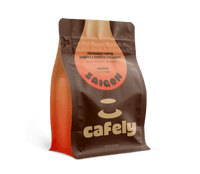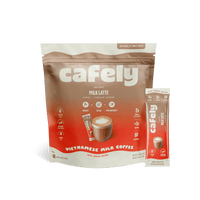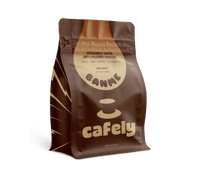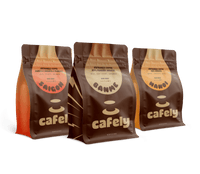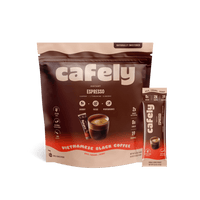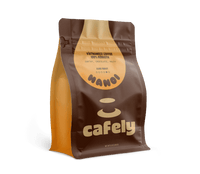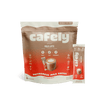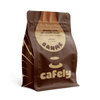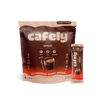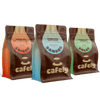The Chemex is a beautifully designed and iconic coffee brewer celebrated for its elegant simplicity and the clean, pure coffee it produces.
The Chemex employs a pour-over method similar to the Hario V60 or standard drip coffee machines but stands out due to its classy glass construction and proprietary bonded paper filters.
Chemex paper filters remove most of the coffee oils and sediments, resulting in a coffee that is smooth, nuanced, and free of bitterness. It’s an excellent system for crafting lighter, fruity, or tea-like coffee varieties like yirgacheffe, geisha, or bourbon.

Chemex Brewing Specs
- Brew Time: 4 minutes
- Coffee/Water Ratio: 1:17
- Grind: Medium-Coarse (like table sugar)
- Water Temperature: 208ºF (98ºC)
- Recommended Coffee: Da Lat Coffee
Chemex Brewing Summary
- Prepare your Chemex with a fresh filter
- Measure & grind your coffee
- Bloom your coffee with a small amount of water
- Add the rest of your water slowly & wait to finish brewing
- Give the final brew a swirl to redistribute & pour into your cup
Tools You’ll Need
To brew coffee using a Chemex, you’ll need the following items/ingredients:
- Chemex — This tool is available in 4 sizes, from 16 to 50 oz. We prefer the original 30 oz size.
- Paper Filters — Make sure you use the Chemex proprietary paper filters only. Thinner paper is likely to rip during the brewing process.
- High-Quality Coffee — Opt for freshly roasted, high-quality beans, ideally the best coffee for Chemex, to get the best results.Avoid brewing robusta coffee with this system.
- Coffee Grinder — A burr grinder will provide the best grind consistency, but a blade grinder or a small blender will do the trick too. Aim for a fine grind with a coarseness similar to sand.
- Hot Water — For Chemex brewing, you’ll want to opt for a ratio of around 1:15 coffee to water. The total amount of water will depend on the size of your press.
- Food Scale (Optional, but Recommended) — We highly recommend using a food scale to measure your coffee and water by weight rather than volume for this precision brewing system.
- Gooseneck Kettle (Optional, but Recommended) — This specialty kettle allows for a more even and consistent pour without disturbing the grounds of the coffee.
- Cup or Mug — This system contains its own built-in carafe and must be poured into serving glasses to drink.
Step-By-Step Instructions: Chemex
Here’s a simple process for brewing coffee using a Chemex.
Step 1: Prepare Your Chemex

Add the Chemex-specific paper filter to the top of the cone, pour some hot water to wet the filter, and preheat the glass.
Pour out any water that drips through before adding your coffee.
Step 2: Measure & Grind Your Coffee

The amount of coffee you’ll need will vary according to the size of your Chemex (chart below).
Use a coffee grinder to prepare whole beans or purchase a bag of pre-ground coffee to skip this step entirely.
Chemex Coffee to Water Ratios
|
Chemex Size |
Servings |
Coffee |
Water |
|
3-Cup Chemex (16 oz) |
1–2 servings |
30 grams |
500 grams |
|
6-Cup Chemex (30 oz) |
3–4 servings |
55 grams |
917 grams |
|
8-Cup Chemex (40 oz) |
4–6 servings |
70 grams |
1167 grams |
|
10-Cup Chemex (50 oz) |
6–8 servings |
90 grams |
1500 grams |
Note: We recommend the standard 6-cup Chemex for most users. The larger sizes are great for making coffee for the whole family but can get unwieldy and wasteful for smaller batches. Pour-over style coffee is ideal for single-serving cups of high-grade, precision-extracted coffee.
Step 3: Bloom Your Coffee

Pour some of your hot water over the grounds so they’re just lightly covered in water. Give it a gentle shake and let it sit for 45 seconds to allow all the gases to escape. This is called the bloom stage.
If you want to be precise, aim to pour about 25% of your water during the bloom phase. This works out to around 230 grams for the standard 6-cup Chemex.
Step 4: Add the Rest of the Water

Pour the remainder of your water through your Chemex in a slow, gentle, circular motion.
A gooseneck-style kettle works best for this because it allows you to pour very slowly and minimizes disturbing the surface of the wet coffee grounds. This ensures a more even extraction.
You should start to notice coffee drip through the filter after about 1 minute; the whole process should be done about 3 minutes later.
Step 5: Swirl, Pour, & Enjoy

Remove the filter and spent grounds and give the coffee a quick swirl in the bottom of the Chemex to redistribute any particles that may have settled at the bottom.
Your coffee is now ready to drink. Pour into your cup, sweeten to taste, and enjoy.
Expert Tips & Tricks: Chemex
The Chemex is a simple tool capable of high-precision brewing if you want to take things to the next level. Here are a few simple tricks you can use to make delicious pour-over coffee every time.
1. Don’t Neglect the Bloom
The bloom phase is an important but often overlooked step in the pour-over brewing process. It helps prevent stalling and ensures a more consistent, even extraction.
2. Buy a Gooseneck Kettle
A gooseneck kettle is characterized by a long, thin nozzle that helps you pour your water slowly to avoid disturbing the surface tension of the coffee grounds. You'd be surprised how much of a difference this makes in the final cup. There's a reason why all professional baristas use this style of kettle when brewing their coffee.
3. Preheat Your Equipment
The total brew time for a Chemex is about 4 minutes. During this time, the core water temperature will drop, which could negatively affect the quality of the final brew. Simply heating the glass and filter before you brew with a rinse of hot water slows the temperature drift to maintain ideal extraction temperatures.
4. Rinse the Filter Before You Brew
The Chemex uses a proprietary paper filter, which is much thicker than conventional coffee filters. This filters out unwanted fats and oils from the final brew — creating a lighter, brighter, and clearer taste. The downside is that it also means more paper taste if you don't rinse the filter before you brew.
5. Use a Food Scale
Ditch the guesswork and embrace precision. A food scale helps you achieve a consistent coffee-to-water ratio, which is crucial for replicating that perfect cup. Aim for a 1:16 ratio (1 gram of coffee for every 16 grams of water) as a starting point and adjust based on your taste preference.
6. Get the Grind Right
The grind matters a lot when brewing with any pour-over style coffee. If it's too fine, it will stall, leading to over-extraction and bitter, acidic coffee. If too coarse, the water will rinse straight through, resulting in underextraction and weak, watery coffee.
The ideal grind for the Chemex is medium coarse (like coarse sand). A burr-style grinder is the best for getting the grind just right, but you can achieve this using cheaper blade-style blenders, too, if you're careful.
History of the Chemex

The Chemex was invented in 1941 by German chemist Peter Schlumbohm. His new device combined the efficiency of a coffee maker with cutting-edge Bauhaus design principles. More than 80 years later, it remains a union of minimalist form and practical function.
Its hourglass shape and use of a special paper filter enable a brewing process that facilitates a slow, pour-over process that extracts the subtle flavors of the coffee beans without harsh bitterness.
FAQs & Troubleshooting: Chemex
1. What type of coffee grind should I use for a Chemex?
A medium-coarse grind is ideal for brewing coffee with a Chemex. The grind should be similar in texture to sea salt. Too fine a grind can clog the filter and result in over-extraction. Too coarse a grind can lead to under-extraction and a weak brew.
2. How much coffee and water should I use in a Chemex?
The general recommendation is a 1:17 coffee-to-water ratio by weight. For example, for every 1 gram of coffee, use 17 grams (or milliliters) of water. This ratio can be adjusted based on personal taste preferences. More water means a lighter coffee, less brews a bolder, darker coffee.
3. What’s the ideal water temperature for brewing with a Chemex?
The ideal water temperature for brewing with a Chemex is around 208ºF (98ºC). Water at this temperature will extract the coffee flavors perfectly without overextracting undesirable bitter compounds.
4. How long should the coffee brew in a Chemex?
The total brew time for a Chemex should be between 3.5 to 4.5 minutes. This includes the time for the initial bloom (30 seconds) and the subsequent pouring stages. The brew time can vary based on the amount of coffee, grind size, and the size of your Chemex.
5. Why does my Chemex coffee taste bitter or sour?
Bitterness in Chemex coffee often results from over-extraction, which is typically caused by too fine a grind, too much coffee, or too long a brew time. Sourness usually indicates under-extraction, which can occur when the coffee grind is too coarse, not enough coffee was used, or if the brew time is too short. Adjusting these variables can help balance the flavor.
6. Can I reheat coffee brewed in a Chemex?
Yes, you can reheat coffee — but it's best enjoyed fresh to appreciate its full flavor profile. Reheating coffee alters its taste and aroma. If you must reheat, do so gently over low heat or with a microwave in short bursts.
7. How do I clean my Chemex?
Rinse the Chemex with warm water after each use. For a deeper clean, use a mild detergent and a long-handled brush to scrub the inside gently. The Chemex can also be placed in the dishwasher if it fits, but the wooden collar should first be removed.
8. Can I use regular paper filters in a Chemex?
You should always use Chemex's own bonded paper filters or their reusable metal filter. These filters are specifically designed for this brewer. They’re thicker than regular paper filters, which will tear and dump coffee grounds into your coffee.
9. Why is my Chemex brewing too slow/fast?
If your Chemex brews too slow, the grind may be too fine, or the filter could be clogged. If it brews too fast, the grind might be too coarse, allowing water to pass through without proper extraction. Adjusting the grind size should help achieve the desired brew time.
